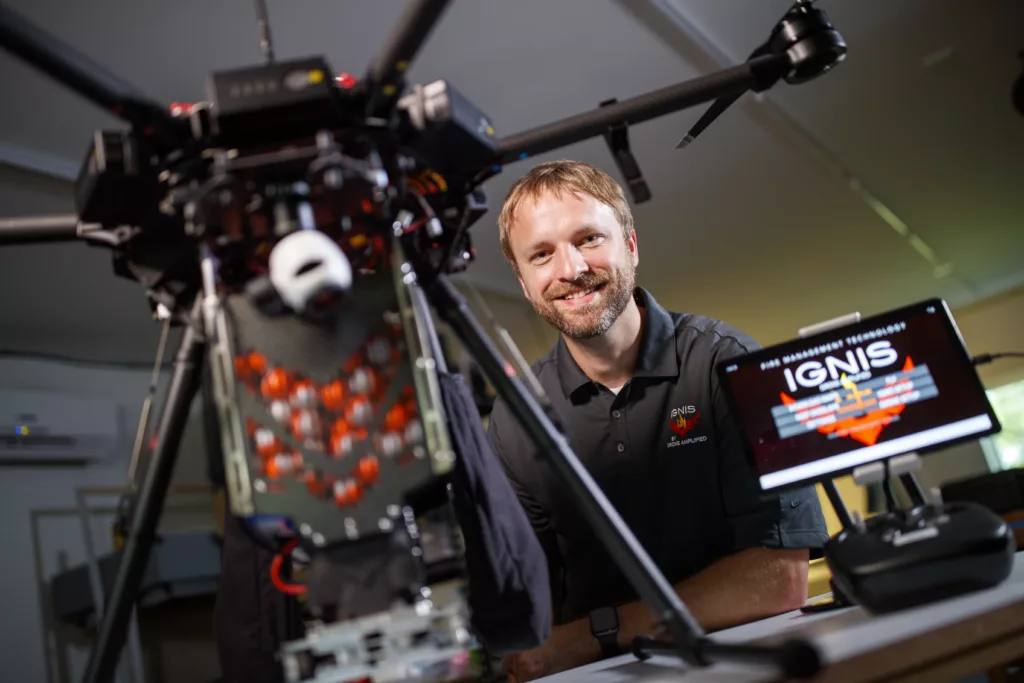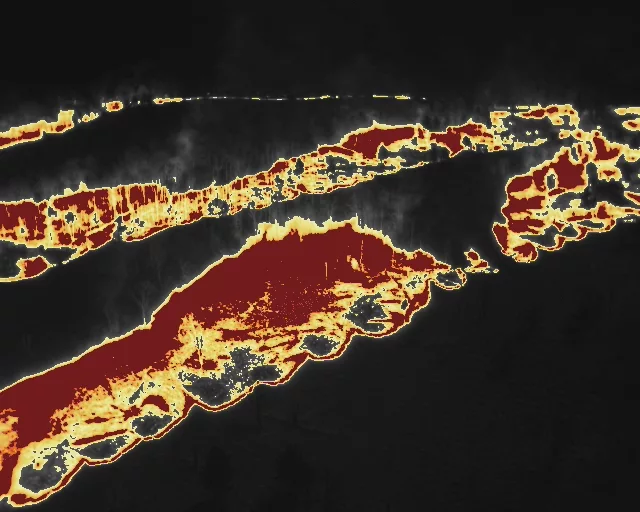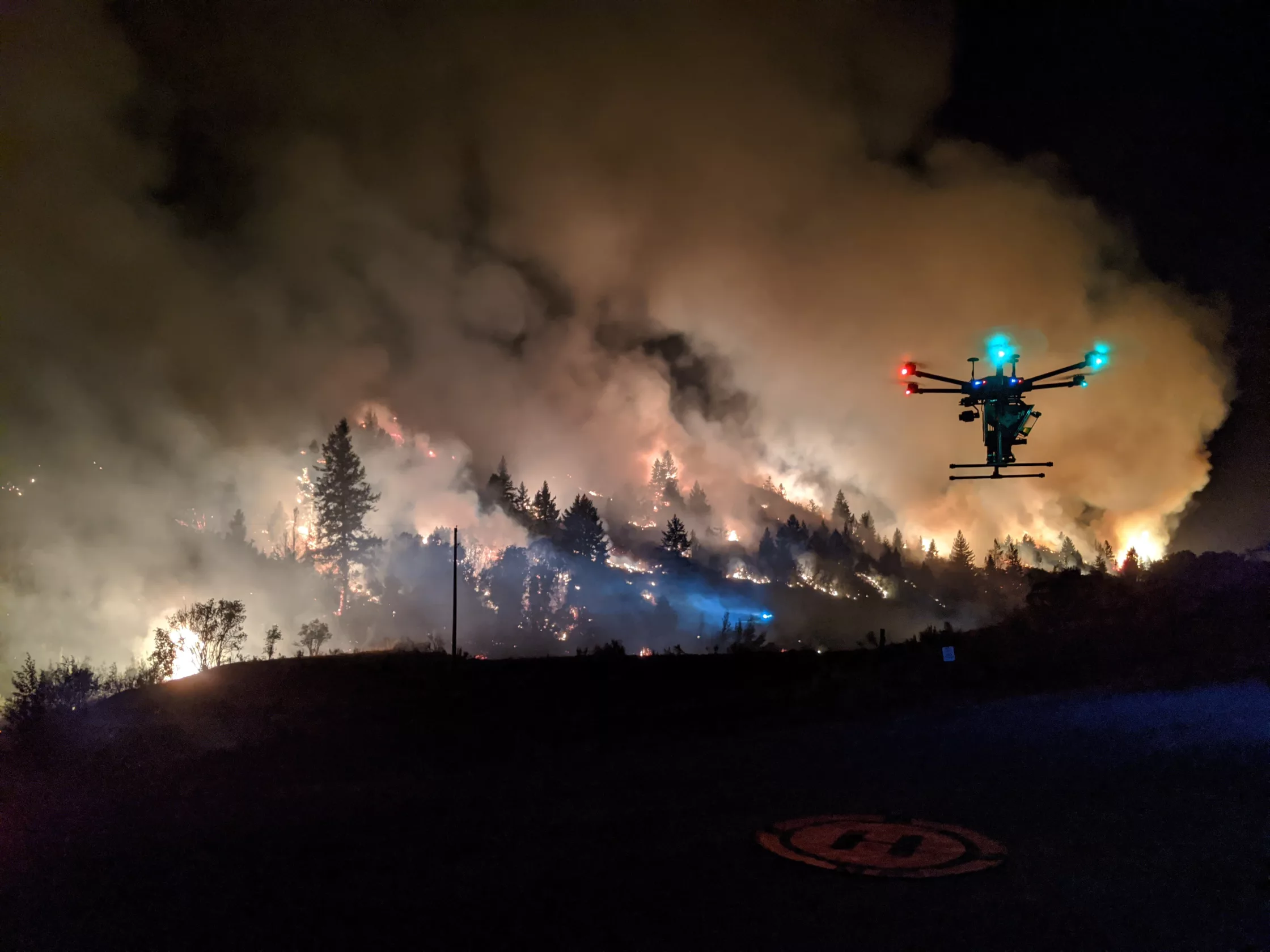Prescribed burns have been happening in North America for centuries, first lit by Native Americans long before European settlers set foot on the continent. Responders light them to prevent wildfires from getting out of control. In the past they did this using potentially dangerous techniques — either on the ground manually or from helicopters.
Today, there’s a safer approach: Drones.
Started by two University of Nebraska-Lincoln professors, a company called Drone Amplified creates drones that firefighters can operate to set prescribed burns. Their technology is now used by firefighters across the country, taking humans out of harm’s way and providing a more efficient method of burning.
“This isn’t just a toy or something that somebody is enjoying playing with,” co-founder and CEO Carrick Detweiler said. “It’s really a tool that is changing how firefighters work, improving their capabilities and saving lives.”
The use of these fire-starting drones created in Nebraska has spread across the globe, with the system now being used in Australia, New Zealand, Germany and Canada, Detweiler said.
Prescribed burns are meant to burn the brush on the bottom of a forest floor, so the wildfire lacks fuel and can’t get more severe once it reaches the prescribed burn area. They are also used to manage vegetation, reduce hazardous fuel loads near developed areas, restore natural woodlands and manage landscapes, according to the U.S. Forest Service.
“You see on the news, a lot of the light retardant drops and airplanes dropping water and stuff. But it turns out a lot of the time they’re actually using fire to fight fire,” Detweiler said.
Detweiler learned this while working as a University of Nebraska-Lincoln Computer Science and Engineering Professor. As Detweiler was searching for uses for drones, a UNL faculty member and wildfire ecologist explained the challenges of wildland firefighting. From there, Detweiler and another college professor, Sebastian Elbaum, saw a niche for drone use.

Prior to their resulting company’s emergence, firefighters used two techniques, according to Detweiler: a person would hold a drip torch and walk or ride an all-terrain vehicle along the area, or they would pilot a helicopter to drop ignition spheres. The method was risky. Around a quarter of wildland firefighting deaths are related to aviation.
Detweiler and Elbaum decided they could put their drone expertise to work. After a couple years developing prototypes, they commercialized Drone Amplified around 2017.
Now, firefighters can light controlled burns without stepping into harm’s way.
Drone Amplified’s IGNIS system dispenses ignition spheres — ping-pong ball sized containers that hold the chemical potassium permanganate. Users then inject these with a second chemical, glycol, which causes the spheres to start a small fire around 30 to 60 seconds after release. A drone can carry 400 per flight, and drop up to eight balls per acre.
“You can burn a pretty large area even in a single flight,” Detweiler said.
Drone Amplified attaches the system to drones like the Freefly Alta X, and then modifies them to better accommodate firefighters. Their drones have visual thermal cameras so firefighters can locate fires. Users can control it all using an app.

While developing the drone, the company worked closely with the United States Department of Interior’s Forest Services. Where most drone software has broader uses, Detweiler said they worked with the department to develop specific capabilities and tools for firefighters in the wild.
“The thing that makes us proud is that when we talk to firefighters, they’re like ‘this is a game changer,’” Detweiler said. “This is changing the way [firefighters] operate.”
Consider Raven Environmental Services, a Texas-based environmental consulting and natural resource management company.
Brett Lawrence, a Raven employee who spearheaded their use of drones for burning, said they’ve been doing prescribed burns since the company was founded in 1996. The company jumped on board with Drone Amplified in 2018, and now use it as frequently as they can.
“It’s definitely a huge impact here,” Lawrence said. “I’m encouraged by what I see. I think more and more people are embracing it and recognizing its value.”
Lawrence said drones have helped Raven become both more efficient and safer.
With the IGNIS software, they’re able to use data to analyze how many acres need to be burned. The drones are also quicker, letting them burn more ground in a day. They can get wildfire smoke dissipated more efficiently, which can matter in urban and suburban areas.
The drone also keeps employees and others safe, as they aren’t putting themselves in grueling conditions in front of blazing fires.
“Folks would traditionally be dragging ignition torches through pretty unforgiving terrains,” Lawrence said. “Now, we’re keeping them out of those hazardous environments.”
Lawrence said Raven workers are thrilled to not have to do all the groundwork. Their clients mostly are thrilled, too. Though some are a little hesitant about the new system, most are very receptive to the new technology, Lawrence said.
“For obvious reasons, the drone is conspicuous,” Lawrence said. “It’s large, it’s kind of got the cool factor going on and people’s responses are overwhelmingly positive.”
Raven now uses drones in roughly two-thirds of their prescribed burns, Lawrence said.
Detweiler sees Drone Amplified continuing to change how drones can be used, potentially expanding even further past mitigating wildfires. Starting this fall, he’ll be going on leave at UNL to focus on the company, which just opened an office near Philadelphia.
“It’s been a really exciting past five years or so,” Detweiler said. “I think we’re going to continue to have exciting years to come here as we continue to advance technologies to make this work.”
This story was originally published by Silicon Prairie News, FFP’s sister news outlet devoted to all things related to Nebraska startups and small businesses.



1 Comment
When the idea was first floated to the public about the concept of the Innovation Campus project at UNL my mind exploded with potential possibilities right here in Nebraska. While this may or may not have any association with it, it still reveals the possibilities.